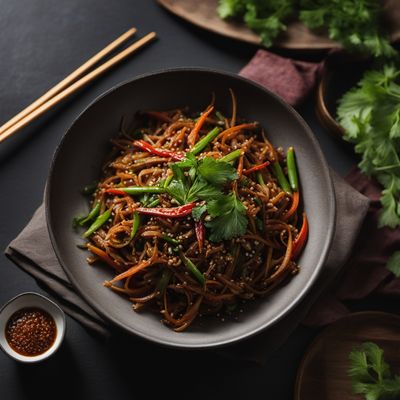
Recipe
Butajiru - Japanese Pork Soup
Umami Delight: Savory Japanese Pork Soup
4.3 out of 5
Indulge in the flavors of Japan with this authentic Butajiru recipe. This hearty pork soup is a staple in Japanese cuisine, known for its rich umami taste and comforting qualities.
Metadata
Preparation time
20 minutes
Cooking time
30 minutes
Total time
50 minutes
Yields
4 servings
Preparation difficulty
Easy
Suitable for
Gluten-free, Dairy-free, Low-carb, High-protein, Paleo-friendly
Allergens
Soy (in miso paste and soy sauce)
Not suitable for
Vegan, Vegetarian, Keto
Ingredients
-
500g (1.1 lb) pork belly, thinly sliced 500g (1.1 lb) pork belly, thinly sliced
-
1 tablespoon vegetable oil 1 tablespoon vegetable oil
-
1 onion, thinly sliced 1 onion, thinly sliced
-
2 cloves garlic, minced 2 cloves garlic, minced
-
1 small daikon radish, peeled and sliced 1 small daikon radish, peeled and sliced
-
2 carrots, sliced 2 carrots, sliced
-
1 cup sliced mushrooms (shiitake or cremini) 1 cup sliced mushrooms (shiitake or cremini)
-
2 cups shredded cabbage 2 cups shredded cabbage
-
2 cups spinach leaves 2 cups spinach leaves
-
4 cups dashi stock 4 cups dashi stock
-
3 tablespoons miso paste 3 tablespoons miso paste
-
2 tablespoons soy sauce 2 tablespoons soy sauce
-
1 tablespoon mirin (Japanese sweet rice wine) 1 tablespoon mirin (Japanese sweet rice wine)
-
2 green onions, chopped 2 green onions, chopped
-
Salt and pepper to taste Salt and pepper to taste
Nutrition
- Calories (kcal / KJ): 380 kcal / 1590 KJ
- Fat (total, saturated): 25g, 8g
- Carbohydrates (total, sugars): 12g, 6g
- Protein: 28g
- Fiber: 4g
- Salt: 2g
Preparation
-
1.Heat the vegetable oil in a large pot over medium heat. Add the pork slices and cook until browned.
-
2.Add the onion and garlic to the pot and sauté until fragrant.
-
3.Add the daikon radish, carrots, mushrooms, and cabbage to the pot. Stir-fry for a few minutes until slightly softened.
-
4.Pour in the dashi stock and bring to a boil. Reduce the heat to low and simmer for 15 minutes.
-
5.In a small bowl, whisk together the miso paste, soy sauce, and mirin until well combined. Add the mixture to the pot and stir gently.
-
6.Add the spinach leaves and simmer for an additional 5 minutes until wilted.
-
7.Season with salt and pepper to taste.
-
8.Serve the Butajiru hot, garnished with chopped green onions.
Treat your ingredients with care...
- Pork belly — For a leaner option, you can use pork loin instead of pork belly. However, pork belly adds a rich flavor and tenderness to the soup.
- Dashi stock — If you can't find dashi stock, you can substitute it with chicken or vegetable broth, but the authentic flavor may vary slightly.
- Miso paste — Choose a red or white miso paste according to your preference. Red miso has a stronger and saltier flavor, while white miso is milder and slightly sweeter.
Tips & Tricks
- To enhance the umami flavor, you can add a small piece of kombu (dried kelp) to the soup while simmering.
- Adjust the thickness of the soup by adding more or less dashi stock according to your preference.
- Feel free to customize the vegetables based on what you have available or your personal taste preferences.
- Serve the Butajiru with a side of pickled vegetables for a refreshing contrast of flavors.
- Leftovers can be stored in the refrigerator for up to 3 days and reheated for future meals.
Serving advice
Serve the Butajiru in individual bowls, accompanied by a bowl of steamed rice. Sprinkle some chopped green onions on top for added freshness and color.
Presentation advice
For an authentic presentation, serve the Butajiru in traditional Japanese soup bowls. Garnish with a small drizzle of sesame oil and a sprinkle of sesame seeds for an extra touch of flavor and visual appeal.
More recipes...
For Japanese cuisine » Browse all
More Japanese cuisine dishes » Browse all

Gomme
Gomme is a traditional drink from France made with gum arabic, sugar, and water. It is a sweet and refreshing drink that is often used as a mixer...

Olive Sanuki Wagyu
Olive Sanuki Wagyu is a premium Japanese beef that is known for its rich flavor and tenderness.

Teriyaki
Teriyaki is a Japanese cooking technique in which foods are broiled or grilled with a glaze of soy sauce, mirin, and sugar. The word "teriyaki"...






